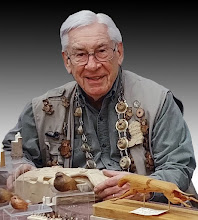This BLOG is sponsored by “Misty Hollow Carving”. You
are welcome to visit Misty Hollow and see all of my carvings.
My Web Site is a like a Gallery – please drop in for a
stroll through.
To help me promote my Web Site please copy this URL address
and email to someone today http://www.murraylincoln.com/
My Deep Reflections
on the Ig Nobel Awards – I’m Amazed!
It
is not a word that I use often. Perhaps never. But I recognized it immediately.
The
word is ‘ignoble’ – meaning 1. Not honorable in character or purpose, 2. Of
humble origin or purpose.
I
can’t figure why I don’t use it more often. Most of my friends are ignoble and
so am I – at least the second part of the definition – the humble part.
But
when I was reading the word wasn’t ‘ignoble’ it was ‘ignobel’ or ‘ig nobel’. The difference caught my eye
immediately. The ‘Nobel’ I recognized
right away – but putting ‘ig’ with it twisted my mind.
That
is exactly what it was designed to do. Brilliant!
So
you haven’t heard of ‘ig nobel’ before? Just like me.
The
‘Ig Nobel’ is actually an award that is presented annually to people around the
world for discovering or investigating the usual. I think that is a great way to explain the
concept or the word.
It
bears the ‘humble origin or purpose’ thought for sure. It also is ‘not honorable
in character or purpose’.
And
yet it is very seriously looked at each year in October by certain groups at
Harvard University. No kidding.
Wikipedia
states the following about “Ig Nobel” – quote –
“The Ig Nobel Prizes are an American parody of the Nobel
Prizes and are given each year in early October for ten unusual or
trivial achievements in scientific research. The stated aim of the prizes is to
"first make people laugh, and then make them think". The awards are
sometimes veiled criticism (or gentle satire). End quote.
They
spend time on doing all the research and investigation on all the submissions
sent their way for a possible Ig Nobel Award. There are only 10 give out each
year.
The
minute that I hit upon the idea I needed to know more. What kind of awards are there?
Are
you ready for these…? Here are some of
the awards passed out at the ceremony this past week or so.
PSYCHOLOGY PRIZE: Anita Eerland and Rolf
Zwaan [THE NETHERLANDS] and Tulio
Guadalupe [PERU, RUSSIA, and THE NETHERLANDS] for their study
"Leaning to the Left Makes the Eiffel Tower Seem Smaller"
PEACE PRIZE: The
SKN Company [RUSSIA], for converting
old Russian ammunition into new diamonds.
ACOUSTICS PRIZE: Kazutaka
Kurihara and Koji
Tsukada [JAPAN] for creating the SpeechJammer — a machine that
disrupts a person's speech, by making them hear their own spoken words at a
very slight delay.
NEUROSCIENCE PRIZE: Craig Bennett, Abigail
Baird, Michael
Miller, and George
Wolford [USA], for demonstrating that brain researchers, by using
complicated instruments and simple statistics, can see meaningful brain
activity anywhere — even in a dead salmon.
CHEMISTRY PRIZE: Johan Pettersson [SWEDEN and RWANDA]. for solving the
puzzle of why, in certain houses in the town of Anderslöv, Sweden, people's hair turned
green.
LITERATURE PRIZE: The US Government
General Accountability Office, for issuing a report about reports about reports
that recommends the preparation of a report about the report about reports
about reports.
PHYSICS PRIZE: Joseph
Keller [USA], and Raymond
Goldstein [USA and UK], Patrick
Warren, and Robin Ball [UK], for calculating the balance of forces that shape and
move the hair in a human ponytail.
FLUID DYNAMICS PRIZE: Rouslan
Krechetnikov [USA, RUSSIA, CANADA] and Hans Mayer [USA] for studying the
dynamics of liquid-sloshing, to learn what happens when a person walks while
carrying a cup of coffee.
ANATOMY PRIZE: Frans
de Waal [The Netherlands and USA] and Jennifer Pokorny [USA] for discovering that chimpanzees can identify other
chimpanzees individually from seeing photographs of their rear ends.
MEDICINE PRIZE: Emmanuel
Ben-Soussan and Michel
Antonietti [FRANCE] for advising doctors who perform colonoscopies how
to minimize the chance that their patients will explode.
And…
SPECIAL
ANNOUNCEMENT: We are now, in 2012,
correcting an error we made in
the year 1999, when we failed to include one winner's name. We now correct
that, awarding a share of the 1999 physics prize to Joseph Keller. Professor
Keller is also a co-winner of the 2012 Ig Nobel physics prize, making him a
two-time Ig Nobel winner.
The
corrected citation is: 1999 PHYSICS PRIZE: Len Fisher [UK and Australia] for
calculating the optimal way to dunk a biscuit, and Jean-Marc Vanden-Broeck [UK
and Belgium] and Joseph Keller [USA], for calculating how to make a teapot
spout that does not drip.
But
the very best one – the greatest Ig Nobel Award in my mind was handed out in
2009 to Dr. Elena Bodnar… as seen below…
Ig Nobel Prize Winner Dr.
Elena Bodnar demonstrates her invention (a brassiere that can quickly convert into
a pair of protective face masks) assisted by Nobel
laureates Wolfgang
Ketterle (left), Orhan Pamuk, andPaul Krugman (right). Photo credit: Alexey
Eliseev, 2009 Ig Nobel
Ceremony
The
Web Site that has all this information states that the following…
Who
organizes the Ig Nobel Prizes?
The Ig Nobel Prizes are organized by the
magazine Annals of Improbable
Research. The ceremony is co-sponsored by the Harvard-Radcliffe
Society of Physics Students, the Harvard-Radcliffe
Science Fiction Association, and the Harvard
Computer Society.
And
today you may well be doing something that could earn you an Ig Nobel if just
the right people hear about it.
Go
for it!
Murray
Lincoln




No comments:
Post a Comment